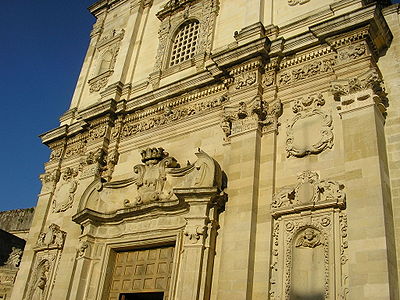POGGIARDO
Poggiardo is a small agricultural
centre in the Salento peninsular, which offers ideas for a
cultural visit to its historical centre and the chance to
learn about the Messapian culture by visiting the Archaeological
Park of Vaste.
Vaste was inhabited since the Iron Age, reaching its maximum
development towards the mid 4th Century BC, after Messapian
defeat of the Greek colony in Taranto.
There have been finds from this period: a Necropolis and tombs
containing funerary treasures. Here one can visit the famous
Cariatidi Ipogeo (Hypogean), an ornate tomb supported by four
caryatid arches.
The City became Roman after defeat of the Greek-Messapian
League, commanded by King Pirro (265 BC), following the historical
course of the Republic and the Empire; at the end of which
there were barbaric invasions by the Visigoths and Vandals.
The City was among the first to be converted to Christianity
as Salento’s geographic position was a natural point
of arrival for the apostles and first Christians coming from
the Holy Land.
During recent digs, four churches on four different levels
were found, dating back to the V, VI, VII and IX centuries,
probably dedicated to S. Stefano.
After a brief period of Ostrogoth Reign (496-535) and the
Greek-Gothic War (535-553), Bastae became a Byzantine centre
for many centuries. During this period, Salento saw the arrival
of Basilian monks escaping from iconoclastic politics inaugurated
by Leone III Isaurico during 725 and the subsequent bloom
of religious hypogean art.
Being part of the Eastern Roman Empire put it at the centre
of clashes between the Normans and Byzantines beginning during
the 11th Century, until a sad epilogue: its destruction by
the Norman Guglielmo Malo in 1156.
Here is where the history of Poggiardo began, through destruction
of Bastae and the last 3 surviving rural homes (Soranello,
Puzze and Casicalvi). The inhabitants entrusted the choice
to an ox, deciding that they would build the new centre in
the place where the animal stopped to graze.
The City passed under Swabian domination (1194) and under
the Angioini (1266), and enjoyed some development due to the
benefits given by the latter for siding with them. The first
nucleus around the castle was built during this period.
The Aragonese then dominated the City (1442-1502) and built
its City walls. It then passed over to the Spanish (1506-1734)
and became and Episcopal seat in 1537, giving it more importance
among centres in Puglia. It was finally passed to the Bourbons
who administered until its unification to the Reign of Italy
(1861).
Poggiardo immediately unveils its historical heart through
numerous noble buildings in the centre (Palazzo Episcopo,
Palazzo Circolone, Palazzo Cotrino, Palazzo Sticchi) and its
main example of civil architecture in Palazzo Ducale Guarini.
Important artistic religious buildings are: the Baroque style
Parrocchiale (Parish Church) with its Rococò façade
and the Madonna della Grotta.
Once outside the City, one can visit the Rupestrian Santi
Stefani Church, containing precious Medieval frescoes.
|
